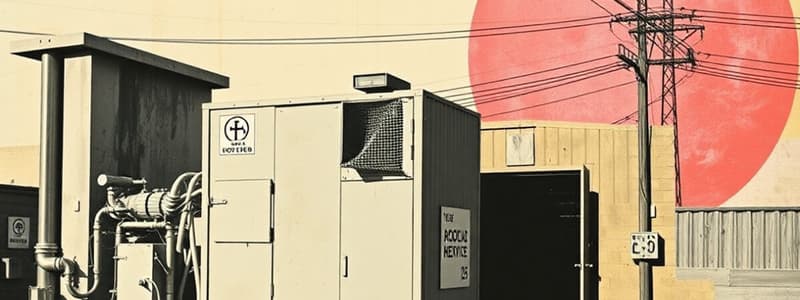Podcast
Questions and Answers
Which material is considered the best electrical conductor?
Which material is considered the best electrical conductor?
- Copper
- Silver (correct)
- Gold
- Aluminum
What is a circular mil?
What is a circular mil?
- A unit of voltage drop
- A unit of electrical resistance
- A unit of circular cross-sectional area (correct)
- A unit of metallic weight
What is the primary purpose of insulation on conductors?
What is the primary purpose of insulation on conductors?
- To enhance conductivity
- To reduce weight of the conductor
- To increase the diameter of the cable
- To provide electrical isolation and physical protection (correct)
What type of cable is commonly referred to as Romex?
What type of cable is commonly referred to as Romex?
What characteristics do underground feeder (UF) cables possess?
What characteristics do underground feeder (UF) cables possess?
Which cable type is described as suitable for exposed above-grade conditions?
Which cable type is described as suitable for exposed above-grade conditions?
What is a characteristic of armored cable (AC or ACT)?
What is a characteristic of armored cable (AC or ACT)?
What differentiates metal-clad (MC) cable from armored cable?
What differentiates metal-clad (MC) cable from armored cable?
What is the primary function of a generator in a power station?
What is the primary function of a generator in a power station?
Which component is directly responsible for driving the rotation of the armature shaft in a generator?
Which component is directly responsible for driving the rotation of the armature shaft in a generator?
What is the role of service entrance conductors in a building's electrical system?
What is the role of service entrance conductors in a building's electrical system?
Which equipment allows for disconnecting electrical service from the utility company?
Which equipment allows for disconnecting electrical service from the utility company?
What is typically referred to as the service lateral in a building's electrical setup?
What is typically referred to as the service lateral in a building's electrical setup?
What is the primary purpose of power substations in the electrical distribution system?
What is the primary purpose of power substations in the electrical distribution system?
What do panelboards in a building's electrical system achieve?
What do panelboards in a building's electrical system achieve?
What kind of equipment is utilized for measuring and recording electrical energy consumed?
What kind of equipment is utilized for measuring and recording electrical energy consumed?
What is the primary function of an overcurrent protection device?
What is the primary function of an overcurrent protection device?
Which type of circuit breaker is the most commonly used?
Which type of circuit breaker is the most commonly used?
What do fuses have in common regarding their functionality?
What do fuses have in common regarding their functionality?
What is the primary rating that determines an overcurrent protection device's maximum continuous carrying capacity?
What is the primary rating that determines an overcurrent protection device's maximum continuous carrying capacity?
What could occur if an overcurrent protection device is not rated to handle the available fault-current?
What could occur if an overcurrent protection device is not rated to handle the available fault-current?
Which of the following is a characteristic of time delay fuses?
Which of the following is a characteristic of time delay fuses?
How many windings does a single-phase transformer have?
How many windings does a single-phase transformer have?
What does the AIC rating of a circuit breaker indicate?
What does the AIC rating of a circuit breaker indicate?
What is the primary use of thermostat cable?
What is the primary use of thermostat cable?
What is a characteristic feature of concealed knob-and-tube wiring?
What is a characteristic feature of concealed knob-and-tube wiring?
What does the term 'ampacity' refer to in a conductor?
What does the term 'ampacity' refer to in a conductor?
Which statement correctly describes voltage drop in conductors?
Which statement correctly describes voltage drop in conductors?
What materials are commonly used for enclosures?
What materials are commonly used for enclosures?
Which of the following best describes electrical metallic tubing (EMT)?
Which of the following best describes electrical metallic tubing (EMT)?
What type of conduit is characterized as having a thinner wall than rigid metal conduit?
What type of conduit is characterized as having a thinner wall than rigid metal conduit?
Which of the following defines a raceway in electrical applications?
Which of the following defines a raceway in electrical applications?
What is a key characteristic of split-phase motors?
What is a key characteristic of split-phase motors?
What role does the capacitor play in capacitor-start motors?
What role does the capacitor play in capacitor-start motors?
Which type of motor typically has less vibration compared to single-phase motors?
Which type of motor typically has less vibration compared to single-phase motors?
What is the primary function of a motor controller?
What is the primary function of a motor controller?
What is a ground fault?
What is a ground fault?
What does a GFCI circuit breaker provide?
What does a GFCI circuit breaker provide?
What distinguishes arc fault protection?
What distinguishes arc fault protection?
What is the purpose of tamper-resistant receptacles?
What is the purpose of tamper-resistant receptacles?
Study Notes
Power Generation
- A power station houses equipment to generate electrical energy via a generator which converts mechanical energy into electrical energy.
- An armature is the rotating part of the generator, with windings around an iron core rotating through a magnetic field, producing current flow.
- A turbine is connected to the generator and drives the rotation of the armature shaft.
- Power substations are small facilities with transformers, switches, and other electrical equipment to reduce transmission voltages.
Service Entrance
- Service entrance conductors carry power from the transformer to the building's service disconnects.
- Overhead conductors are called the service drop and underground conductors, the service lateral.
- The service entrance includes components connecting the utility-supplied wiring to the service disconnects, excluding the meter.
- The service entrance equipment receives the service entrance conductors.
- An electric meter, used by the utility company, measures and records electrical energy consumption.
- A service disconnect switches off the electrical service from the utility, disconnecting power to the building.
Distribution and Control
- Switchboards are large cabinets that contain switches, overcurrent protection, and other equipment to divide large amounts of electrical current.
- Panelboards are smaller cabinets that serve as a single unit, including buses, overcurrent protection devices, and other equipment.
- Building transformers are used in transmitting and distributing power from the power plant to a substation.
- Single-phase transformers have a single primary and secondary winding, while three-phase transformers have three primary and three secondary windings.
Overcurrent Protection (OCP)
- Overcurrent protection devices (OCP) safeguard the building service or individual circuits from excessive current flow.
- Circuit breakers act as switches and automatically trip off when current exceeds the circuit rating.
- Thermal-magnetic circuit breakers are the most popular type.
- Fuses are OCP devices with a metal strip that melts when current exceeds its rating.
- There are three basic fuse types: plug fuses, Edison-base plug fuses, and cartridge fuses.
OCP Device Ratings
- OCP devices have two current ratings: overcurrent and amperes interrupting current.
- The overcurrent rating is the highest amperage an OCP device can carry continuously without exceeding a specific temperature limit.
- Interrupting rating is the maximum possible fault-current an OCP device can interrupt without damage.
- Amperes interrupting current (AIC) rating for circuit breakers is 5000 A, and 10,000 A for fuses.
Utilization Equipment and Devices
- Utilization equipment is designed to perform a specific mechanical, chemical, heating, or lighting function via electrical energy.
- An electrical conductor is any material that conducts electrical current.
- A circular mil is a circular cross-sectional area unit, equal to the area of a circle with a diameter of one mil.
- Buses are electrical conductors that serve as common connections for two or more electrical circuits.
Conductor Material
- Silver is the best electrical conductor but copper and aluminum are more economical.
- Aluminum is used in building conductor installations due to its weight and cost advantages.
Conductor Insulation
- Conductors are covered with insulation providing electrical isolation and physical protection.
- A cable contains multiple conductors bundled together with an outer sheathing for protection during installation.
Cable Types
- Nonmetallic-sheathed cable, type NM/NMC, is commonly called Romex.
- Underground feeder (UF) cables are flame retardant and resistant to moisture, fungus, and corrosion.
- Service entrance (SE) cable is suitable for exposed, above-grade conditions, with underground service entrance (USE) cable used underground applications.
- Armored cable, type AC/ACT, is sometimes called BX cable.
- Metal-clad (MC) cable is similar to armored cable, with fewer size limitations.
- Flat conductor cable (FCC) is a wiring system with thin cable and special connectors.
- Thermostat cable is used for low-voltage applications like doorbells, chimes, and thermostats.
- Cords are made of stranded conductors within a flexible insulated sheathing material.
- Concealed knob-and-tube (K&T) wiring, an older wiring technique, uses insulated conductors strung between knobs and tubes.
Conductor Power Loss
- Heat generated by current flow through a conductor results in power loss or line loss.
Conductor Ampacity
- A conductor's ampacity is the maximum current it can carry continuously without exceeding the temperature limitations of the insulation and sheathing material.
Voltage Drops in Conductors
- Voltage drop is proportional to power loss because current flow remains constant. This means power loss results in a voltage reduction.
Enclosure and Raceways
- Enclosures are electrical boxes and cabinets providing protection for conductors, connections, controls, and other electrical equipment.
- Electrical boxes are metal or plastic enclosures that hold devices like switches and outlets.
- A raceway is an enclosed channel for holding wires, cables, or busbars.
Raceway Types
- Rigid metal conduit is a heavy galvanized steel or aluminum tube.
- Intermediate metal conduit (IMC) is a galvanized steel or aluminum tube with a thinner wall than rigid metal conduit.
- Electrical metallic tubing (EMT) is a thin-walled galvanized steel or aluminum tube available in diameters up to 4 in.
Electric Motors
- A split-phase motor starts slowly with low torque and is not suitable for heavy loads.
- Capacitor-start motors utilize a capacitor to store and discharge energy for starting.
- Induction motors use electromagnetic induction to rotate the rotor.
- Three-phase motors are lighter, less costly, and vibrate less than single-phase motors.
- Dual-voltage motors operate on one of two different line voltages.
Motor Controllers
- A motor controller is a device designed to start, stop, and protect the motor.
Need for Occupant Protection
- Electrocution occurs when small amounts of electrical current flow through the heart for 1 to 3 seconds.
- Tamper-resistant receptacles have built-in shutter systems to prevent objects from touching live components.
Ground Fault Protection
- A ground fault is unintentional flow of electrical current between a power source and a grounded surface.
- GFCI devices protect against ground faults by interrupting the circuit when a ground fault occurs.
- GFCI devices are available in receptacle outlet, circuit breaker, and portable types.
Arc Fault Protection
- An arc fault is unintentional electrical discharge characterized by low and erratic current.
- AFCI devices protect against arc faults.
- AFCI devices come in circuit breaker, convenience outlet, and portable types.
Studying That Suits You
Use AI to generate personalized quizzes and flashcards to suit your learning preferences.
Related Documents
Description
This quiz covers fundamental concepts related to power generation and service entrance components in electrical systems. It includes information on generators, turbines, substations, and the role of service entrance conductors in delivering electricity. Test your knowledge on these essential electrical engineering topics!





